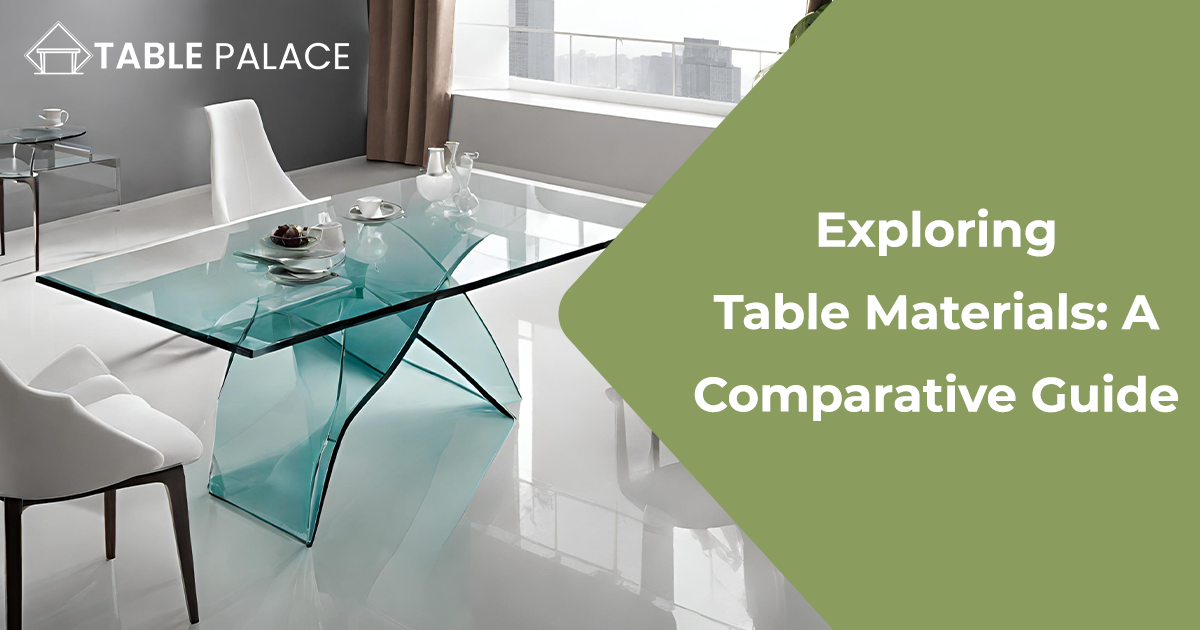Choosing the right material for your table isn’t just a matter of taste; it’s about understanding the characteristics, benefits, and limitations of each material to make an informed decision that suits your lifestyle, budget, and decor. Common table materials include wood, metal, glass, stone, and composites, each offering unique aesthetic and functional properties. This guide provides a comparative look at these materials to help you select the perfect table for your home or office.
Wood
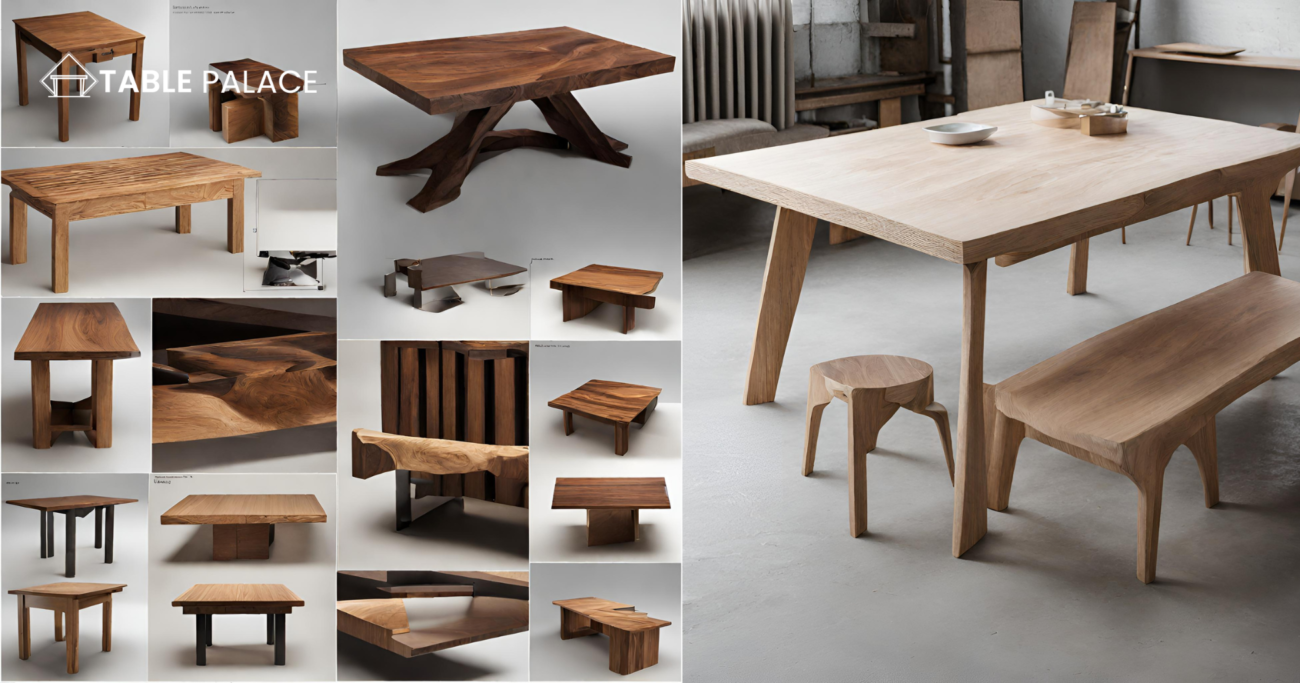
Wood tables offer a diverse range of options, each sourced from different tree species, contributing distinct colors, grains, and levels of durability to the final product. Hardwoods, including oak, maple, and cherry, are renowned for their robustness and long lifespan. Oak boasts a prominent grain pattern and a warm, golden-brown hue, while maple provides a smoother grain and a lighter, more neutral tone. Cherry wood, with its rich reddish-brown color, adds a touch of elegance. On the other hand, softwoods, exemplified by pine, present a more cost-effective option, featuring a lighter color palette and a softer grain.
Pros and Cons:
Wood is cherished for its natural beauty and versatility, allowing artisans to craft tables in a myriad of styles ranging from rustic to contemporary. The warm, organic feel of wood contributes to a welcoming atmosphere in any space. However, it is important to acknowledge some drawbacks. Wood is susceptible to scratches, stains, and changes in humidity. Scratches can mar the surface, stains may be challenging to remove, and fluctuations in humidity can lead to warping or cracking. The cost of wood tables can vary significantly based on the type and quality of the wood, with hardwoods generally commanding a higher price due to their durability and aesthetic appeal.
Best Use Cases:
Wooden tables exhibit remarkable versatility, seamlessly fitting into various settings and design aesthetics. They thrive in traditional interiors, exuding a timeless charm that complements classic furniture and decor. Rustic spaces benefit from the natural, earthy tones of wood, while modern interiors can be enriched with sleek, minimalist wooden designs. Wood tables are particularly well-suited for dining rooms, where they can serve as focal points, offering both functionality and aesthetic appeal. In office settings, the warmth of wood contributes to a comfortable and productive atmosphere, while in living rooms, wooden tables often serve as statement pieces that tie the entire room together.
Care and Maintenance:
To ensure wood tables maintain their beauty over time, a diligent care routine is essential. Regular dusting with a soft, dry cloth helps prevent the accumulation of dirt and debris. Immediate cleanup of spills is crucial to prevent stains, as wood is absorbent. Periodic polishing using a mild wood cleaner or polish not only enhances the table’s luster but also nourishes the wood. Avoiding direct sunlight is key to preventing fading and discoloration over time. Additionally, using coasters under hot or wet items provides an extra layer of protection against damage, preserving the table’s integrity and prolonging its overall lifespan.
Metal
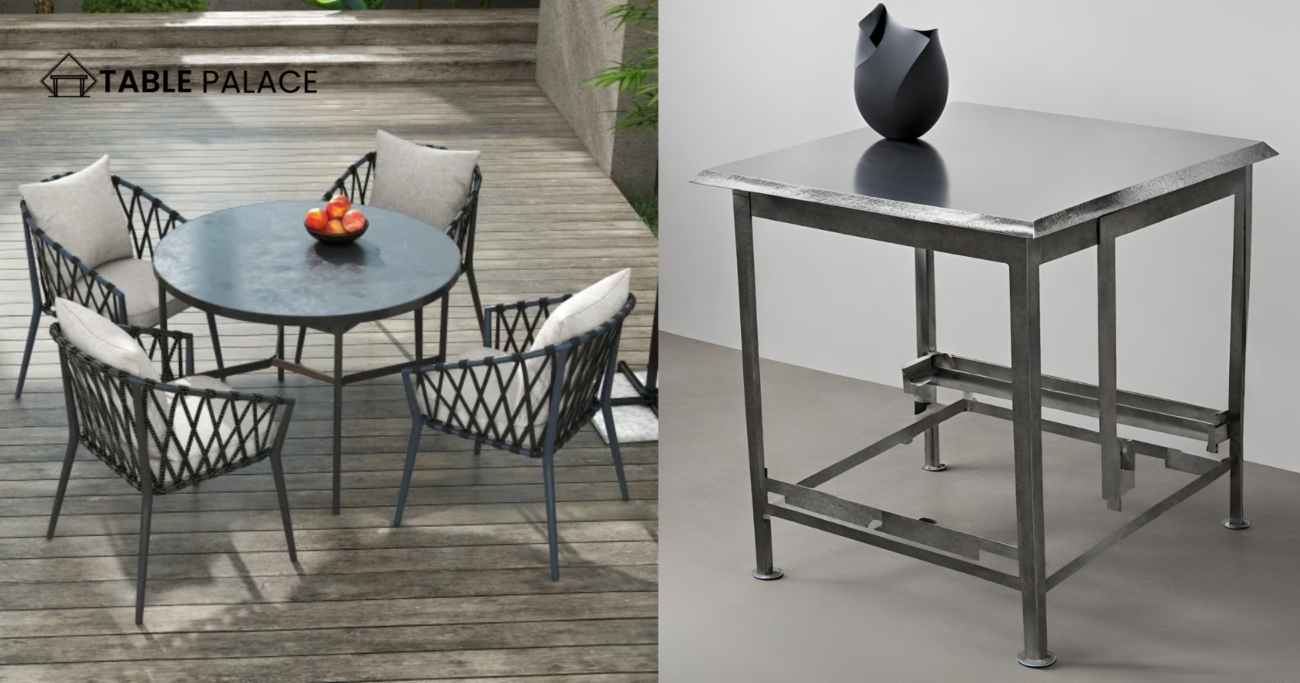
Metal tables showcase a range of materials, predominantly iron, steel, and aluminum, each offering a unique aesthetic and tactile experience. Iron tables exude an industrial heft, providing a robust and substantial feel. Steel, with its sleek and modern appearance, introduces a contemporary edge to the design. On the other hand, aluminum tables are celebrated for their lightweight versatility, making them easy to maneuver and suitable for various settings.
Pros and Cons:
Metal tables are distinguished by their durability, capability of withstanding heavy use, and providing a long-lasting furniture solution. They are less susceptible to damage from spills compared to other materials, making them an excellent choice for areas with high traffic. Metal tables generally require minimal maintenance, simplifying the care routine. However, it’s essential to note that metals like iron and steel can be prone to rust, particularly in humid or outdoor environments. Additionally, some may find metal tables to be cold or impersonal in certain settings.
Best Use Cases:
Metal tables find their ideal placement in modern, industrial, and minimalist decors where their sleek, clean lines can enhance the overall aesthetic. The industrial charm of metal complements contemporary designs, making them suitable for urban lofts and modern apartments. Additionally, metal tables excel in outdoor settings due to their durability, resisting the elements with ease.
Care and Maintenance:
Maintaining the appearance of metal tables is relatively straightforward. Regular wiping with a damp cloth helps remove dust and prevent the accumulation of dirt. Avoiding the use of harsh chemicals is crucial to prevent damage to the metal finish. For iron and steel tables, occasional treatment with a rust inhibitor is beneficial, especially in environments with high humidity or exposure to the elements. This preventive measure helps protect against rust formation, ensuring the longevity and appearance of the metal. Additionally, keeping metal tables free from scratches and dents will contribute to their continued visual appeal.
Glass
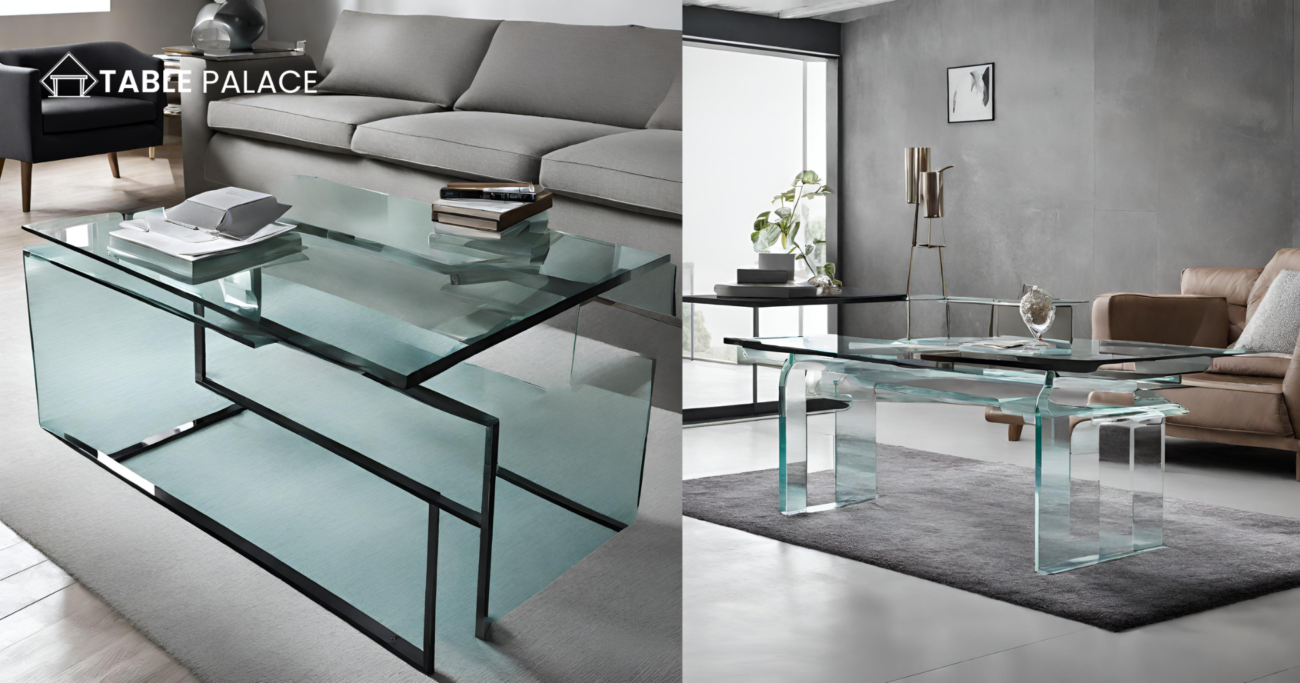
Glass tables often utilize tempered glass for safety and enhanced durability. However, they can also be crafted from different glass types, including frosted, clear, or tinted glass, offering a diverse range of aesthetic possibilities to suit individual preferences.
Pros and Cons:
Glass tables introduce a modern aesthetic and create an illusion of larger, more open spaces. The use of tempered glass enhances safety by reducing the risk of breakage into sharp shards. Glass tables are easy to clean, promoting a sleek and polished appearance. However, they are prone to showing fingerprints and smudges, requiring frequent cleaning to maintain their pristine look. Glass, while durable, can be susceptible to chipping or cracking upon impact, necessitating careful handling.
Best Use Cases:
Glass tables are particularly well-suited for smaller spaces where the transparency of the material contributes to a light and airy feel, making the room appear more spacious. They excel in contemporary settings, seamlessly integrating with modern furniture and design elements. Glass tables are also suitable for areas where visual continuity and an unobtrusive presence are desired.
Care and Maintenance:
Maintaining the clarity and cleanliness of glass tables involves using a glass cleaner or a mixture of vinegar and water, applied with a soft cloth or paper towel. Regular cleaning helps minimize the visibility of fingerprints and smudges, preserving the transparent aesthetic. It’s essential to exercise caution and avoid placing heavy items directly on the glass surface to prevent potential chipping or cracking. Using pads or coasters under heavier objects provides an additional layer of protection against scratches. Careful handling and preventive measures contribute to the longevity and visual appeal of glass tables.
Stone
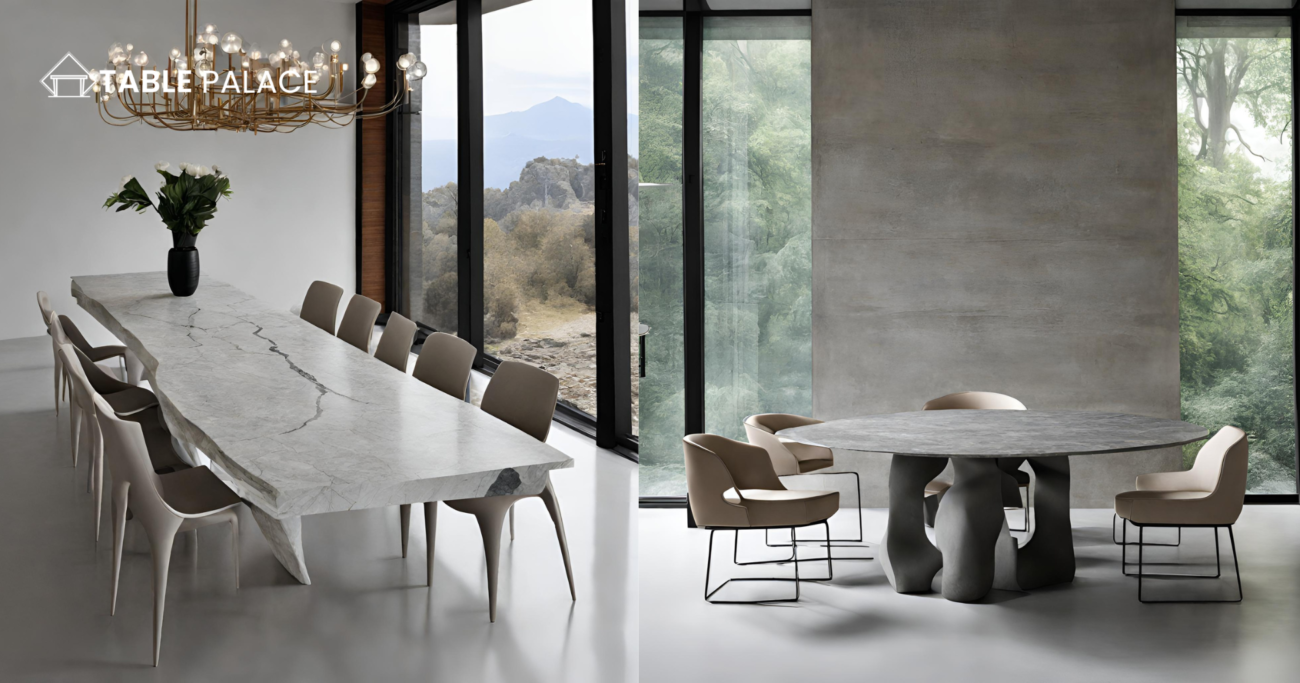
Stone tables showcase a variety of popular materials, including marble, granite, quartz, and slate. Each stone type brings forth a distinct pattern and color, contributing to the creation of unique, one-of-a-kind tables.
Pros and Cons:
Stone tables are renowned for their exceptional durability, capable of lasting a lifetime and beyond. They exhibit remarkable resistance to heat, making them suitable for various applications. Cleaning stone tables is relatively straightforward, typically requiring a mild detergent. However, they do have some drawbacks, including being notably heavy, expensive, and potentially porous. The porous nature of certain stones, like marble and granite, requires regular sealing to prevent the absorption of liquids and potential staining.
Best Use Cases:
Stone tables stand out as statement pieces, often serving as focal points in a room due to their elegance and inherent beauty. They find their ideal placement in formal dining rooms, where their luxurious appearance complements refined settings. Additionally, stone tables are well-suited for luxury spaces seeking to make a visual impact. Their durability also makes them suitable for outdoor areas, where they can withstand the elements while retaining their aesthetic appeal.
Care and Maintenance:
To ensure the longevity and pristine appearance of stone tables, proactive care and maintenance are crucial. Immediate attention to spills is essential to prevent potential staining. Cleaning with a mild detergent and a soft cloth or sponge helps maintain cleanliness without causing damage to the stone surface. Regular resealing, as recommended for specific stone types, is vital to enhance their resistance to liquids and stains. To prevent scratching and etching, it’s advisable to use trivets and placemats under hot items and tableware. This preventive measure safeguards the stone surface from potential damage, ensuring the table retains its beauty over time.
Composite Materials
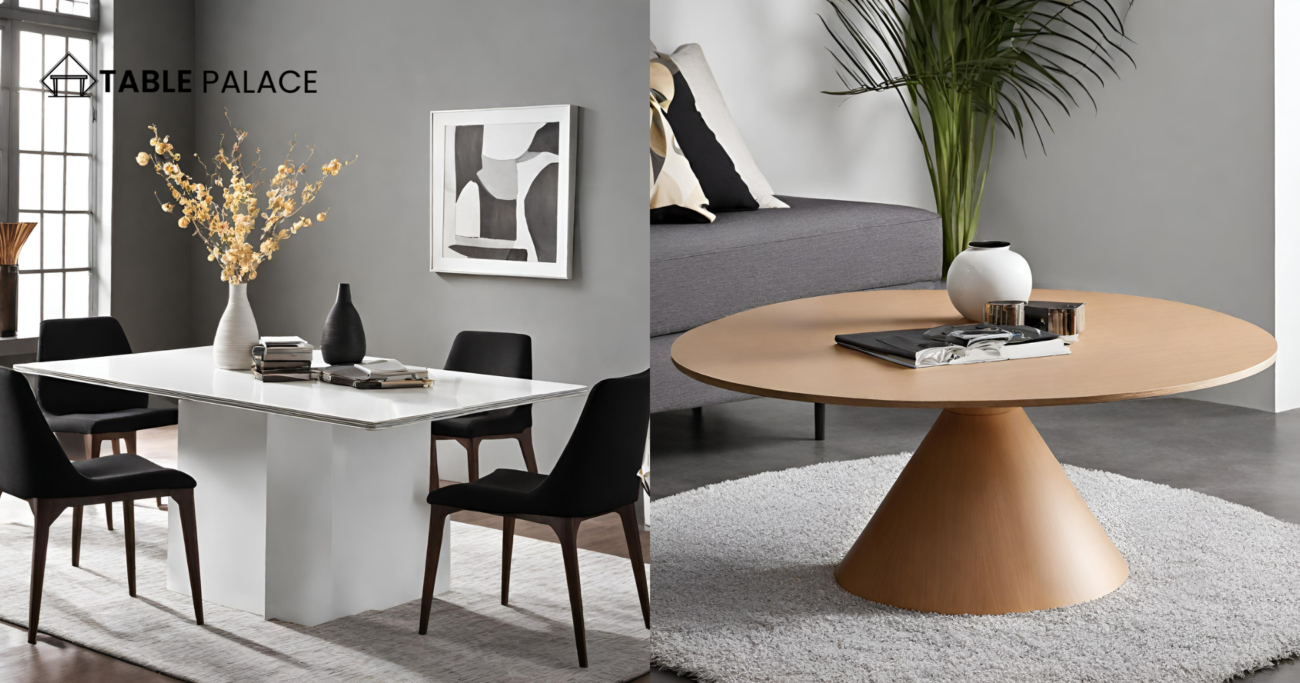
Composite tables utilize materials such as Medium Density Fiberboard (MDF), particle board, and synthetic laminates. These materials are commonly employed to replicate the aesthetic of wood or stone while offering a more budget-friendly alternative.
Pros and Cons:
Composite materials are distinguished by their affordability and lightweight characteristics. They present a wide array of colors and styles, providing versatility in design options. However, these materials do have drawbacks. While cost-effective, composites are not as durable as natural materials, and they may be susceptible to wear and tear over time. Additionally, they can be vulnerable to water damage, which may impact their longevity.
Best Use Cases:
Composite tables serve as a practical choice for individuals on a budget, offering an affordable alternative that mimics the look of more expensive materials. They are particularly well-suited for children’s furniture, where cost-effectiveness and the ability to withstand the wear and tear of active use are crucial. Additionally, composite tables are suitable for temporary applications, providing a functional solution without long-term commitment.
Care and Maintenance:
To preserve the condition of composite tables, it is important to keep them dry and clean. Regular cleaning with a damp cloth helps remove dust and prevents the accumulation of dirt. It’s advisable to avoid placing hot items directly on the surface to prevent potential heat damage. To safeguard against water rings, using coasters under glasses and other tableware is a simple yet effective preventive measure. While composite tables may not boast the same durability as natural materials, proper care, and preventive measures can extend their lifespan, making them a practical and cost-effective choice for specific use cases.
Comparative Analysis
Durability and Longevity:
When considering the durability and longevity of table materials, stone and metal stand out as the most resilient. Stone, such as granite or marble, and metal, particularly iron and steel, are capable of withstanding the test of time. Wood and glass, while offering a moderate lifespan, can endure well if properly maintained. Composites, while versatile in design, generally have the shortest lifespan, being more prone to wear and tear over time.
Aesthetic Appeal:
The aesthetic appeal of a table is significantly influenced by the chosen material. Wood imparts a sense of warmth and timelessness, creating a cozy and inviting atmosphere. Metal introduces an industrial edge, adding a sleek and modern touch to the space. Glass creates an illusion of space and openness, contributing to a contemporary and airy feel. Stone, such as marble or granite, exudes luxury and sophistication, making a bold statement. Composites, offering versatility in design, can emulate various styles, providing a budget-friendly option with diverse aesthetic possibilities.
Cost Consideration:
Cost considerations play a crucial role in selecting the right table material. Stone, especially high-quality varieties like marble, and certain hardwoods can be among the most expensive options. Metal and glass fall somewhere in between, with costs varying based on the type and design. Composites, being budget-friendly, are often the most affordable option, making them accessible to a broader range of consumers.
Environmental Impact:
Considering the environmental impact of table materials is essential in the current ecological context. Wood, particularly when sourced sustainably, is often considered environmentally friendly. Metal, due to its recyclability, is another eco-conscious choice. However, the environmental impact of composites can be less favorable, as the production process may involve chemicals, and their lower durability may result in more frequent replacements. It is crucial to weigh these factors when making a choice that aligns with environmental sustainability.
Conclusion
Choosing the right material for tables is a nuanced decision influenced by factors such as durability, aesthetic appeal, cost, and environmental impact. Each material, whether it be the enduring stone, the warm wood, the modern metal, the transparent glass, or the versatile composite, brings its own set of advantages and considerations. Balancing personal preferences, intended use, and budget constraints is key to ensuring the selected table not only serves its practical purpose but also enhances the overall aesthetics of the living space. Whether opting for timeless durability, contemporary elegance, or budget-friendly practicality, an informed decision ensures a table that stands the test of time both functionally and aesthetically.

